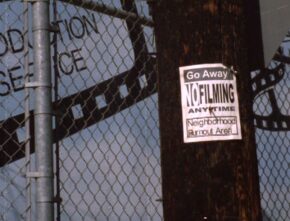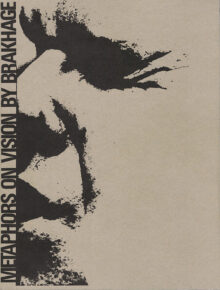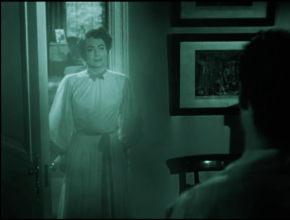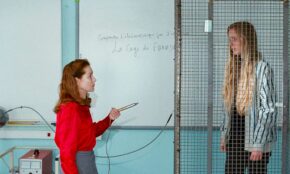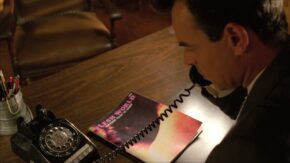CS73
Phantom Thread (Paul Thomas Anderson, US)
By Robert Koehler | 12/19/2017 | CS73, Currency, From Cinema Scope Magazine
By Robert Koehler SoCal being SoCal, it’s hard to leave it, especially if you were born there. The only good joke in Beatriz at Dinner has someone cracking wise about living in Newport Beach and the problem of going on vacation: Where do you go, since the best weather is here? People who don’t know…
Read More → Hollywood, Read: Slow Writing: Thom Andersen on Cinema
By Sean Rogers | 12/19/2017 | Books, Columns, CS73, From Cinema Scope Magazine
By Sean Rogers “I am not trying to make some new meaning from these films; I am striving to bring out the meanings that are there but obscured by the plot lines,” Thom Andersen writes of the method he employed for his film Juke: Passages from the Films of Spencer Williams (2015). Again and again,…
Read More → Exploded View | Stan Brakhage’s Metaphors on Vision
By Chuck Stephens | 12/19/2017 | Columns, CS73, Exploded View, From Cinema Scope Magazine
By Chuck Stephens “Oh, slow-eyed spectator, this machine is grinding you out of existence.”—Stan Brakhage Stan Brakhage’s Metaphors on Vision—first published in 1963 by Jonas Mekas as a fabulously special issue of Film Culture, designed by Fluxus forefather George Maciunas, bound in beautifully corrugated cardboard pierced with an eyehole, beyond whose vellum retina lurked Brakhage’s…
Read More → Global Discoveries on DVD: Fantasies and Favourites
By Jonathan Rosenbaum | 12/19/2017 | Columns, CS73, DVD Reviews, From Cinema Scope Magazine
By Jonathan Rosenbaum Circa 1978, while I was living in a San Diego suburb and teaching a film course, I wrote a letter to Dr. Seuss (Ted Geisel), who lived in another San Diego suburb, inviting him to come to my class and talk about The 5,000 Fingers of Dr. T (1953), which he co-wrote…
Read More → The Green Fog (Guy Maddin, Evan Johnson, Galen Johnson, US/Canada)
By Lawrence Garcia | 12/19/2017 | CS73, Fall Festival Spotlight, Festivals, From Cinema Scope Magazine, Spotlight
By Lawrence Garcia That Guy Maddin’s feature-length follow-up to his most monumental work to date—the staggering mise en abyme of The Forbidden Room (2013)—would be The Green Fog, a 63-minute, found-footage video reimagining of Alfred Hitchcock’s Vertigo (1958), is entirely apropos (and a rather Maddin-esque sleight-of-hand) when one considers the fanfare with which The Green…
Read More → Madame Hyde (Serge Bozon, France/Belgium)
By Blake Williams | 12/19/2017 | CS73, Fall Festival Spotlight, Features, From Cinema Scope Magazine, Spotlight
By Blake Williams “It’s a cry echoed by a thousand sentinels An order relayed by a thousand heralds A beacon flaring up a thousand citadels A call to hunters lost in the great woods…” — Charles Baudelaire, “Les Phares” (1857) “A woman of fire makes no sense.” — Madame Hyde (Isabelle Huppert) In…
Read More → Cocote (Nelson Carlo de Los Santos Arias, Dominican Republic/Argentina/Germany)
By Jay Kuehner | 12/19/2017 | CS73, Fall Festival Spotlight, Features, From Cinema Scope Magazine, Spotlight
By Jay Kuehner The titular nape of the neck invoked in the word cocote is both a marked corporeal designation and an intimation of something bad about to happen. In Cocote, it represents the site of a beheading and the dreaded aura of imminent retribution. If hacer cogote translates as “to expect something,” then such…
Read More → The Uses of Disenchantment: Guillermo del Toro’s The Shape of Water
By Adam Nayman | 12/19/2017 | CS73, Features, From Cinema Scope Magazine
By Adam Nayman Accepting the Golden Lion at Venice for The Shape of Water, Guillermo del Toro magnanimously offered this piece of advice to young filmmakers: “Have faith in whatever you have faith in.” This bit of winner’s-circle tautology was surely not meant to be condescending. As with his fellow awards-ceremony-orator Lin-Manuel Miranda’s observation at…
Read More → 3/4 (Ilian Metev, Bulgaria/Germany)
By Jordan Cronk | 12/19/2017 | CS73, Festivals, From Cinema Scope Magazine, Spotlight
By Jordan Cronk A modest work of considerable grace and insight, Ilian Metev’s 3/4 quietly stands as one of the most accomplished narrative debuts of the year. Genuinely compassionate, the 36-year-old Bulgarian’s directorial voice echoes forth confidently from the opening frames of this most understated of family dramas. Following the Semaine de la Critique fêted…
Read More → Three Billboards Outside Ebbing, Missouri (Martin McDonagh, UK/US)
By Angelo Muredda | 12/19/2017 | CS73, Currency, From Cinema Scope Magazine
By Angelo Muredda There’s a moment early in Martin McDonagh’s Three Billboards Outside Ebbing, Missouri that neatly encapsulates the playwright-turned-filmmaker’s competing instincts toward moral sophistication and childish self-indulgence. As the bereaved protagonist Mildred Hayes (Frances McDormand) struts through the local sign shop—the first step in her campaign to use the title’s eponymous placards to shame…
Read More → CS73 Editor’s Note
By Mark Peranson | 12/19/2017 | Columns, CS73, From Cinema Scope Magazine
By Mark Peranson It’s true that the bulk of the films that are covered in any particular issue of this magazine first show publically at film festivals, and, in many cases, only show at festivals. Thus, once again in this last issue of the year, we present a small selection of reviews from films that…
Read More → The Limits of Control: Lucien Castaing-Taylor & Véréna Paravel’s Caniba
By Samuel La France | 12/19/2017 | CS73, Features, From Cinema Scope Magazine
By Samuel La France “The person we love we dream only of eating. That is, we slide down that razor’s edge of ambivalence.”—Hélène Cixous, Love of the wolf To begin with a spoiler, Caniba concludes with a miracle—or at least this is how the film’s subject, the infamous Japanese cannibal Sagawa Issei, describes the sudden…
Read More → Issue 73 Table of Contents
By Cinema Scope | 12/19/2017 | CS73, From Cinema Scope Magazine, Table of Contents
Interviews Sightsurf and Brainwave: Blake Williams’ PROTOTYPE by Michael Sicinski In the Shadow of the Magic Kingdom: Sean Baker on The Florida Project by Adam Cook Giving Credibility to the Universe: Hélène Cattet and Bruno Forzani on Laissez bronzer les cadavres by Christoph Huber Features The Uses of Disenchantment: Guillermo del Toro’s The Shape of…
Read More → Giving Credibility to the Universe: Hélène Cattet & Bruno Forzani on Laissez bronzer les cadavres
By Christoph Huber | 12/15/2017 | CS73, From Cinema Scope Magazine, Interviews
By Christoph Huber “The .22 bullet tore a tiny hole into the canvas. The detonation was marginally louder than the crack of a whip. In the valley a crow protested. Luce emitted a short, husky laugh quite similar to the sound of the crow.” Thus begins Laissez bronzer les cadavres!, the first novel by Jean-Patrick…
Read More → Sightsurf and Brainwave: Blake Williams’ PROTOTYPE
By Michael Sicinski | 12/15/2017 | CS73, From Cinema Scope Magazine, Interviews
By Michael Sicinski Blake Williams is a multi-dimensional character. A writer whose work has frequently graced the pages of this magazine, he is also an academic and a film artist. And, as a filmmaker, he has no time for flatness. No filmmaker since Ken Jacobs has been so consistently committed to exploring the aesthetic potentials…
Read More → 

